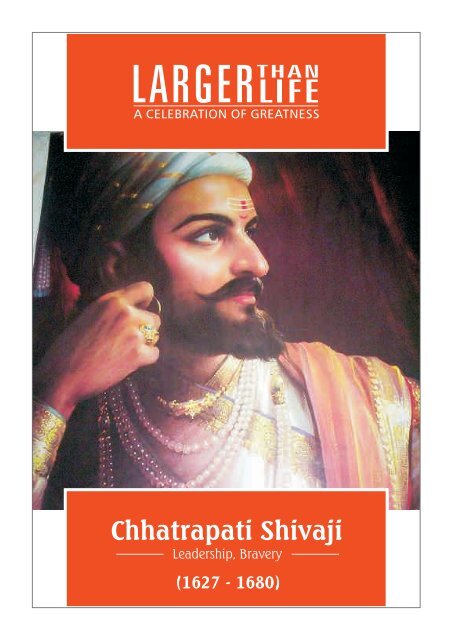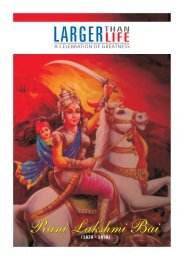Chhatrapati Shivaji Amit Vithalani - The Fifth Veda Entrepreneurs
Chhatrapati Shivaji Amit Vithalani - The Fifth Veda Entrepreneurs
Chhatrapati Shivaji Amit Vithalani - The Fifth Veda Entrepreneurs
You also want an ePaper? Increase the reach of your titles
YUMPU automatically turns print PDFs into web optimized ePapers that Google loves.
<strong>Chhatrapati</strong> <strong>Shivaji</strong><br />
Leadership, Bravery<br />
(1627 - 1680)
<strong>Chhatrapati</strong> <strong>Shivaji</strong><br />
Leadership, Bravery<br />
(1627 - 1680)<br />
INTRODUCTION<br />
• <strong>The</strong> history of India is incomplete without the history of Marathas and <strong>Shivaji</strong> is the<br />
nucleus of Maratha history.<br />
• <strong>Shivaji</strong> Bhosle, also known as <strong>Chhatrapati</strong> <strong>Shivaji</strong> Raje Bhosle was the founder of<br />
Maratha empire in western India in 1674.<br />
• He inspired and united the common man to fight against the tyranny of Mughal ruler<br />
Aurangzeb, by inculcating a sense of pride and nationality in them. He used guerrilla<br />
tactics in attacks.<br />
• He was a brave and able administrator, and established a government that included<br />
such modern concepts as cabinet (Ashtapradhan Mandal), foreign affairs (Dabir),<br />
and internal intelligence.<br />
BIRTH AND EARLY YEARS<br />
<strong>Shivaji</strong> was born in the fort of Shivneri on 19th February 1627. <strong>The</strong> child was named<br />
Shiva, after the local Goddess Shivai.<br />
Shahaji, <strong>Shivaji</strong>'s father appointed the young <strong>Shivaji</strong> under the care of his mother<br />
Jijabai to manage the Pune holdings. <strong>Shivaji</strong> took oath of swarajya at the temple of<br />
Raireshwar and assumed administrative responsibility in 1644.<br />
Shahaji got Lal Mahal built at Pune. A royal seal was handed over to <strong>Shivaji</strong>. Thus <strong>Shivaji</strong><br />
started his career as an independent young prince of a small kingdom on a mission.<br />
<strong>Shivaji</strong> used the title of Raja (king) only after Shahaji died.<br />
MILESTONES<br />
1646 - 1947: He carried out his first military action by capturing Bijapur kingdom's<br />
Torna fort at age 19, in 1646. By 1647 he had captured Kondana and Rajgad forts and had<br />
complete control of the Pune region.<br />
1656: He conquered Javli from Chandra Rao More.
1657: His troops were soundly beaten by the Mughal army, but the Mughals then withdrew,<br />
and he returned to raiding and several times defeated the Bijapur army.<br />
1659: By 1659, he had captured forts in the Western Ghats and along the Konkan coast. He<br />
vanquished Afzal Khan in the battle of Pratapgarh which was fought on November 30,<br />
1659. To counter the loss at Pratapgad, another army of over 10,000 was sent against<br />
<strong>Shivaji</strong>, commanded by Bijapuri general Rustemjaman. In a pitched battle, the enemy was<br />
crushed and Rustemjaman fled.<br />
1660 - 1663: In 1660, Mughal Governor Shaista Khan occupied Pune. <strong>The</strong>n in 1663,<br />
<strong>Shivaji</strong> made an attack on Shaista Khan's harem and wounded him.<br />
1664: <strong>Shivaji</strong> sacked the rich Mughal port of Surat and thus provoked an organized<br />
Mughal campaign against him.<br />
1665 - 1666: <strong>Shivaji</strong> was Defeated in 1665. In 1666, he went to Agra to negotiate with<br />
Aurangzeb, the Mughal emperor, but was imprisoned. After a daring escape from Agra,<br />
he returned to West India and undertook a series of raids that were not countered by the<br />
Mughals.<br />
1670 - 1674: In 1670,<strong>Shivaji</strong>'s forces launched a concerted attack on Mughal garrisons<br />
in Maharashtra. <strong>The</strong> force of the assault was overwhelming and within six months<br />
<strong>Shivaji</strong> had regained most of his old territory. From 1670 to 1674 <strong>Shivaji</strong> continued to<br />
expand his territory at the expense of the Mughals.<br />
<strong>Shivaji</strong> was formally crowned '<strong>Chhatrapati</strong>' in 1674 at the Raigad fort, and given the<br />
title 'Kshatriya Kulavantas Sinhasanadheeshwar <strong>Chhatrapati</strong> <strong>Shivaji</strong> Maharaj'.<br />
1976: At the end of 1676, <strong>Shivaji</strong> launched a wave of conquests in southern India.<br />
DEATH<br />
<strong>Shivaji</strong> died in 1680 at Raigad. Because of his struggle against an imperial power,<br />
<strong>Shivaji</strong> became an icon of freedom fighters in the Indian independence struggle that<br />
followed two centuries later. He is remembered as a just and wise king and his rule is<br />
called one of the six golden ages in Indian history.
<strong>Chhatrapati</strong> <strong>Shivaji</strong><br />
Leadership, Bravery<br />
(1627 - 1680)<br />
Quiz<br />
1) <strong>Shivaji</strong> was named after the local Goddess ________.<br />
(Fill in the blank.)<br />
2) In which year was <strong>Shivaji</strong> formally crowned '<strong>Chhatrapati</strong>'?<br />
3) <strong>Shivaji</strong>'s rule is called one of the _______ golden ages in<br />
Indian History.<br />
Send in your answers to one2one@clarislifesciences.com<br />
First 3 correct answers will get Clarista coupon worth RS. 50.<br />
Last Quiz Winners<br />
<strong>Amit</strong> <strong>Vithalani</strong> - Development • Pritesh Patel - Xcelris<br />
Lalit Lakum - iCubix






